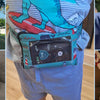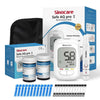Help, my CGM sensor is falling off! Simple ways to keep it in place longer
-
Published on
Last updated on

Is your glucose sensor or patch pump peeling at the edges, catching on clothes or even falling off days before it should? You are definitely not alone. Many people with diabetes struggle to keep their CGM sensor or Omnipod in place during everyday life, sports, swimming or sleep.
That’s one of the reasons we developed the Dia-Band sensor armband and the Dia-Style adjustable armband.
Many CGM users wear a Dia-Band or Dia-Style for sports, swimming and active play. When they notice the adhesive starting to loosen, they also use an armband during sleep or for extra protection in daily life.
Below, we’ll explain why CGM sensors come off too early and share practical tools and tips – from armbands to skin prep and medical tapes – that can help your sensor or pod stay on for the full wear time.
Why does my CGM sensor or pod keep coming off?
There are several reasons why a CGM sensor, infusion set or patch pump might not stay on as long as you’d like:
- Skin type: some people simply have skin that holds adhesive better than others. Oily skin or very dry skin can both reduce adhesion.
- Water and sweat: frequent showers, swimming, saunas or heavy sweating (especially during sports) can weaken the adhesive layer.
- Creams, oils and lotions: applying body lotion, oil or rich shower cream just before a sensor change can make the patch lift within hours.
- Insufficient skin prep: if the skin is not properly cleaned and dried, the plaster may not bond well. Hair at the insertion site can also reduce adhesion.
- Placement on the body: in some locations clothing rubs more, the skin stretches more, or you bump into things more often. All this can make the sensor loosen faster.
Good skin preparation is key:
- avoid fatty creams or lotions just before replacing your sensor or infusion set
- clean the area with a suitable skin cleanser or alcohol wipe
- if needed, carefully shave excess hair at the insertion site
- let the skin and the adhesive dry completely before applying the sensor
In rare cases, alcohol can actually make things worse (for example with very dry or sensitive skin), so you may need to experiment a little to find what works best for you. We are all different, and sometimes it takes a few tries to find the perfect routine.
Finally, the location matters. If you choose a place that is constantly rubbed by clothing or where the skin is under tension, the plaster will be more likely to peel. Wearing a diabetes sensor armband over your CGM can help protect it from friction and bumps.
Tip: If you lose your sensor well before the end date despite taking good precautions, call your supplier or clinic to ask whether you may be eligible for a replacement sensor. In many cases it is possible to get a new one.
Using a Dia-Band or Dia-Style armband to protect your CGM
If your CGM sensor is sticking out or you’re constantly worried about it catching on door frames, backpack straps or sports gear, an armband can make a big difference.
Dia-Band – soft, universal sensor armband
The Dia-Band is a soft, stretchy armband that you wear over your sensor or patch pump. It adds a gentle but secure layer of protection without extra adhesive on the skin. It is ideal for:
- sports and workouts
- swimming and water activities
- active play with children or pets
- sleep, especially if you lie on your sensor side
Dia-Style – adjustable armband for active CGM users
The Dia-Style armband is an adjustable, slimmer strap designed for active CGM users who want a secure fit and fun prints. It is particularly useful if you:
- do high-impact sports or contact sports
- wear your sensor in a spot that often gets bumped
- want a more discreet, close-fitting support strap
Both Dia-Band and Dia-Style can help your sensor survive workouts, swimming sessions and restless nights with more peace of mind.
Skin prep products that help your sensor stay on longer
Besides armbands, many people use skin prep products to improve adhesion or protect sensitive skin. Here are some of the most common options people with diabetes talk about:
Skin Tac Wipes
Skin Tac Wipes are individually packed wipes with a very sticky adhesive that forms an extra layer between your skin and the sensor patch. You open a packet and dab the glue onto the area where you plan to place your sensor or pod.
A simple trick: instead of pulling the wipe fully out, tear the sachet halfway open and hold the packet while dabbing the wipe on your skin. That way you avoid getting your fingers completely sticky.
Cavilon Spray
In warm weather or with sensitive skin, the sensor adhesive can irritate the skin. Cavilon barrier spray is a transparent, non-stinging film that creates a protective layer on the skin.
It can help to:
- reduce irritation and redness from tape
- protect fragile or sensitive skin
- improve how well adhesives stick
Cavilon is alcohol-free, not greasy and can offer protection for up to 72 hours.
Medical tapes and films to reinforce your CGM sensor
Fixomull Stretch
Fixomull Stretch is a white, flexible tape sold in rolls (often 2 or 10 meters) at pharmacies. The material is similar to many infusion set plasters and can be used to reinforce your sensor.
You can draw the outline of your sensor and plaster on the roll, adding an extra 1–1.5 cm around it, and then cut out a custom shape with a hole for the sensor. In other situations, using a small strip just to secure loose edges already works very well.
There are even cutting templates available on the market that help you cut the exact shape you need – like making your own sensor patches.
Opsite Flexigrid
Opsite Flexigrid is a transparent, self-adhesive film often used to cover small wounds or to fix dressings in place. It acts like a “second skin”. The film is waterproof and individually packaged.
Because it is thin and flexible, it can easily be applied on top of a sensor for extra protection. You can also apply the film to your skin first and then place your Freestyle Libre, Dexcom, Omnipod or infusion set on top. This can be particularly useful if you have skin allergies or irritation from sensor adhesives.
Tegaderm
Tegaderm is another thin, transparent, latex-free film dressing very similar to Opsite Flexigrid. You can apply Tegaderm over your sensor for extra protection, or first place the film on your skin and then attach the sensor on top.
This “sensor on film” method can be a good option if you struggle with skin irritation from your CGM, infusion set tape or Omnipod.
Sports tapes and extra plasters for active days
If you are very active, elastic sports tape (such as kinesio tape or Cure Tape) or products like Leukotape can provide extra reinforcement over and around your sensor.
These tapes are available in many colours and prints and can be cut to size. Just make sure you do a small test patch first if you have sensitive skin, and ask your diabetes team if you are unsure where it is safe to add extra tape.
How to remove all that extra glue from your skin
Extra glue is great for keeping your CGM sensor on – but less fun when it’s time to remove everything. Fortunately, you don’t need harsh products to get rid of sticky residue.
A simple option that many people like is to use a cotton pad or soft cloth with a little warm water and baby oil. This is gentle on the skin and removes adhesive residue very effectively.
If you have very sensitive skin or frequent irritation, talk to your diabetes nurse or doctor about suitable adhesive removers and barrier products for you.
Conclusion – find your own combination that works
There is no single perfect solution to keep a CGM sensor or Omnipod from falling off – it’s often about finding the right combination of skin prep, placement, protection and support that works for your body and your lifestyle.
For many people, using a Dia-Band or Dia-Style together with good skin preparation and, if needed, additional medical tapes, already makes a big difference.
And of course, you can discover all our Kaio-Dia accessories for CGM sensors and pumps to support you in your daily life with diabetes.





